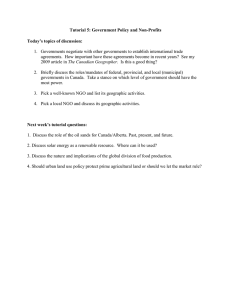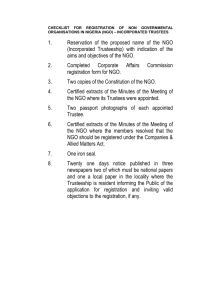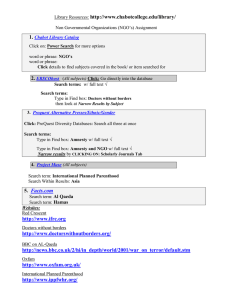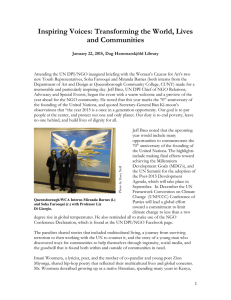First principles study of the structural properties of Ni Co Mn
advertisement
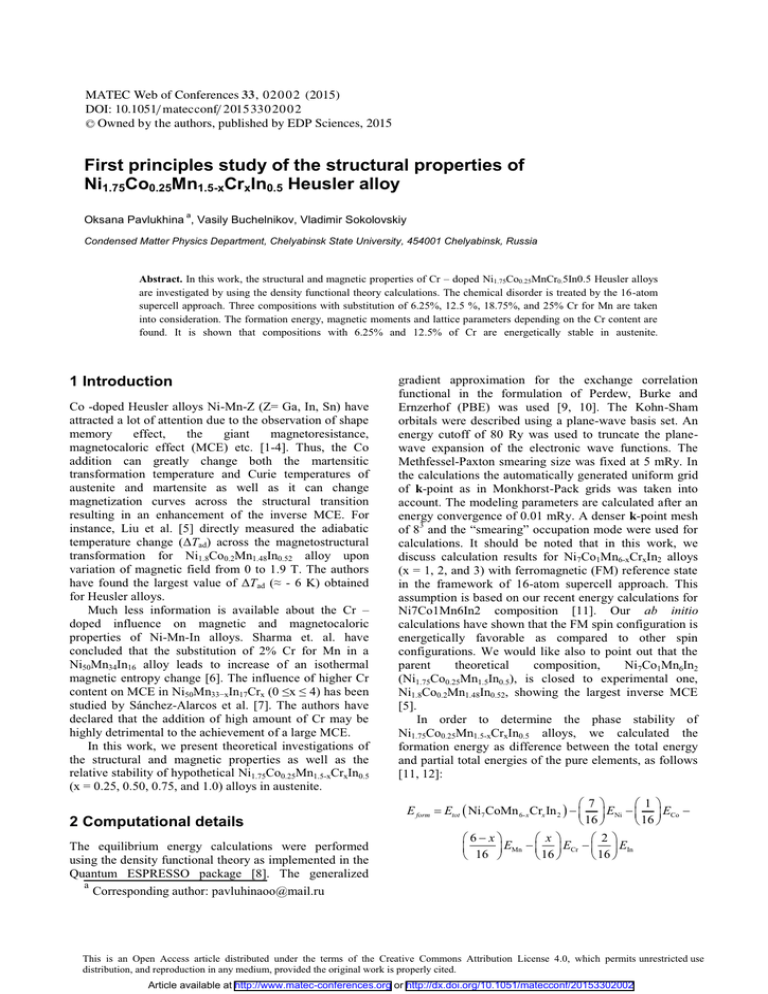
MATEC Web of Conferences 33 , 0 2 0 0 2 (2015) DOI: 10.1051/ m atec conf/ 201 5 33 0 2 0 0 2 C Owned by the authors, published by EDP Sciences, 2015 First principles study of the structural properties of Ni1.75Co0.25Mn1.5-xCrxIn0.5 Heusler alloy a Oksana Pavlukhina , Vasily Buchelnikov, Vladimir Sokolovskiy Condensed Matter Physics Department, Chelyabinsk State University, 454001 Chelyabinsk, Russia Abstract. In this work, the structural and magnetic properties of Cr – doped Ni1.75Co0.25MnCr0.5In0.5 Heusler alloys are investigated by using the density functional theory calculations. The chemical disorder is treated by the 16-atom supercell approach. Three compositions with substitution of 6.25%, 12.5 %, 18.75%, and 25% Cr for Mn are taken into consideration. The formation energy, magnetic moments and lattice parameters depending on the Cr content are found. It is shown that compositions with 6.25% and 12.5% of Cr are energetically stable in austenite. 1 Introduction Co -doped Heusler alloys Ni-Mn-Z (Z= Ga, In, Sn) have attracted a lot of attention due to the observation of shape memory effect, the giant magnetoresistance, magnetocaloric effect (MCE) etc. [1-4]. Thus, the Co addition can greatly change both the martensitic transformation temperature and Curie temperatures of austenite and martensite as well as it can change magnetization curves across the structural transition resulting in an enhancement of the inverse MCE. For instance, Liu et al. [5] directly measured the adiabatic temperature change (ΔTad) across the magnetostructural transformation for Ni1.8Co0.2Mn1.48In0.52 alloy upon variation of magnetic field from 0 to 1.9 T. The authors have found the largest value of ΔTad (≈ - 6 K) obtained for Heusler alloys. Much less information is available about the Cr – doped influence on magnetic and magnetocaloric properties of Ni-Mn-In alloys. Sharma et. al. have concluded that the substitution of 2% Cr for Mn in a Ni50Mn34In16 alloy leads to increase of an isothermal magnetic entropy change [6]. The influence of higher Cr content on MCE in Ni50Mn33−xIn17Crx (0 ≤x ≤ 4) has been studied by Sánchez-Alarcos et al. [7]. The authors have declared that the addition of high amount of Cr may be highly detrimental to the achievement of a large MCE. In this work, we present theoretical investigations of the structural and magnetic properties as well as the relative stability of hypothetical Ni1.75Co0.25Mn1.5-xCrxIn0.5 (x = 0.25, 0.50, 0.75, and 1.0) alloys in austenite. 2 Computational details The equilibrium energy calculations were performed using the density functional theory as implemented in the Quantum ESPRESSO package [8]. The generalized a Corresponding author: pavluhinaoo@mail.ru gradient approximation for the exchange correlation functional in the formulation of Perdew, Burke and Ernzerhof (PBE) was used [9, 10]. The Kohn-Sham orbitals were described using a plane-wave basis set. An energy cutoff of 80 Ry was used to truncate the planewave expansion of the electronic wave functions. The Methfessel-Paxton smearing size was fixed at 5 mRy. In the calculations the automatically generated uniform grid of k-point as in Monkhorst-Pack grids was taken into account. The modeling parameters are calculated after an energy convergence of 0.01 mRy. A denser k-point mesh of 83 and the “smearing” occupation mode were used for calculations. It should be noted that in this work, we discuss calculation results for Ni7Co1Mn6-xCrxIn2 alloys (x = 1, 2, and 3) with ferromagnetic (FM) reference state in the framework of 16-atom supercell approach. This assumption is based on our recent energy calculations for Ni7Co1Mn6In2 composition [11]. Our ab initio calculations have shown that the FM spin configuration is energetically favorable as compared to other spin configurations. We would like also to point out that the parent theoretical composition, Ni7Co1Mn6In2 (Ni1.75Co0.25Mn1.5In0.5), is closed to experimental one, Ni1.8Co0.2Mn1.48In0.52, showing the largest inverse MCE [5]. In order to determine the phase stability of Ni1.75Co0.25Mn1.5-xCrxIn0.5 alloys, we calculated the formation energy as difference between the total energy and partial total energies of the pure elements, as follows [11, 12]: 7 1 E form Etot Ni7CoMn 6- x Crx In 2 ENi ECo 16 16 6 x x 2 EMn ECr EIn 16 16 16 This is an Open Access article distributed under the terms of the Creative Commons Attribution License 4.0, which permits XQUHVWULFWHGXVH distribution, and reproduction in any medium, provided the original work is properly cited. Article available at http://www.matec-conferences.org or http://dx.doi.org/10.1051/matecconf/20153302002 MATEC Web of Conferences Here, Etot(Ni7Co1Mn6-xCrxIn2) is the total energy per formula cell and ENi, ECo, EMn, ECr, and EIn are the total energy per atom of pure Ni, Co, Mn, Cr, and In unit cells, respectively. 3 Results of calculations To determine the total energy of pure Mn element we considered both FM and antiferromagnetic (AF) alignments of magnetic moments in bcc and fcc structures. Our calculations have shown that the most energetically favorable configuration is the fcc structure with the FM spin configuration. In regard to the remaining elements, we used the fcc, simple hexagonal, and bct structures for Ni, Co, and In, respectively. Therefore, in the case of Co and In atoms we were carried out the structure relaxation calculations by two lattice parameters: a and c. The total energy and equilibrium lattice parameters of pure Ni, Co, Mn, Cr, and In atoms are listed in Table 1. It should be noted that calculated lattice parameters are in a good agreement with the experimental data. Table 1. Total energy and equilibrium lattice parameters of pure Ni, Co, Mn, Cr and In atoms. Element Total energy, Ry lattice parameters, Å Ni -339.6066 a=3.528 Co -74.417 a=2.51 c=4.07 Mn -209.2766 a=3.49 Cr -174.092 a=2.91 In -136.6442 a=3.39 c=4.74 The variations of the total energy of the 16-atom supercells for Ni1.75Co0.25Mn1.5-xCrxIn0.5 (x = 0.25, 0.5, 0.75, and 1.0) as a function of the lattice parameter are presented in Fig. 1. As can be seen from Fig. 1, the equilibrium lattice parameter of Ni1.75Co0.25Mn1.5-xCrxIn0.5 alloys does not strongly change with the Cr addition. Besides, it is found to slightly decrease as compared with the parent Ni1.75Co0.25Mn1.5In0.5 compound [13]. The total energy of structure Ni1.75Co0.25Mn1.5xCrxIn0.5, partial total energies of pure elements, and formation energy are listed in Table 2. We can see that in the case of x = 0.25 and 0.5, the total energy per atom of pure elements involved to Ni1.75Co0.25Mn1.5-xCrxIn0.5 compositions is much higher than that total energy of the Ni1.75Co0.25Mn1.25Cr0.25In0.5 and Ni1.75Co0.25MnCr0.5In0.5, suggesting that these compounds are stable in the austenite. In the latter cases, we can observe the opposite situation indicative of the not stable composition. Figure 1. The variation of the total energy of the 16-atom supercells (a) Ni1.75Co0.25Mn1.25Cr0.25In0.5, (b) Ni1.75Co0.25MnCr0.5In0.5, (c) Ni1.75Co0.25Mn0.75Cr0.75In0.5, (d) Ni1.75Co0.25Mn0.5CrIn0.5 as a function of the lattice parameter. 02002-p.2 ESOMAT 2015 Liu et al. has been observed the giant MCE effect in Ni45Co5Mn37In13 [5]. We were considered that the lattice parameter for Ni1.75Co0.25Mn1.5-xCrxIn0.5 does not strongly change with Cr addition (Figure 1) and it was taken as a0 = 5.96 Å for Ni45Co5Mn37In13 [5]. The total energy of structure Ni1.75Co0.25Mn1.5-xCrxIn0.5 and partial total energies of the pure elements are listed in Table 2. Table 2. The combinations of total energy for Ni1.75Co0.25Mn1.5xCrxIn0.5 alloys presented in (Ry). Total energy Partial total energies Ni1.75Co0.25Mn1.25Cr0.25In0.5 -3945.4853 -3945.4266 Ni1.75Co0.25MnCr0.5In0.5 -3910.2717 -3910.242 Ni1.75Co0.25Mn0.75Cr0.75In0.5 -3875.04303 -3875.0574 Ni1.75Co0.25Mn0.5CrIn0.5 -3839.8116 -3839.8728 Compositions of structure and partial energies for involved elements. It was shown that the total magnetic moment and energy of Ni1.75Co0.25Mn1.5-xCrxIn0.5 alloys decrease with Cr content increasing. Besides, compositions with Cr content of 6.25 %, 12.5 % are found to stable in austenite in comparison to the composition with Cr content of 18.75% and 25%. The further additional calculations for the stability of Ni1.75Co0.25Mn1.5-xCrxIn0.5 alloys in martensite would be needed in order to understand the role of Cr in Ni-CoMn-In compounds. Acknowledgment This work was supported by the RFBR (Grant No. 14-0201085), Ministry of Education and Science RF No. 3.2021.2014/K (calculations of total energy) and RSF No. 14-12-00570\14 (calculations of mixing energy). Table 3. The formation energy for Ni1.75Co0.25Mn1.5-xCrxIn0.5 alloys presented in (Ry). References 1. Formation energy 2. Ni1.75Co0.25Mn1.25Cr0.25In0.5 -0.0587 3. Ni1.75Co0.25MnCr0.5In0.5 -0.0297 4. Ni1.75Co0.25Mn0.75Cr0.75In0.5 0.0144 Ni1.75Co0.25Mn0.5CrIn0.5 0.0612 Compositions 5. The equilibrium lattice parameters and magnetic moments depending on the Cr concentration are listed in Table 4. We found that the maximum total magnetic moment is observed for Ni1.75Co0.25Mn1.25Cr0.25In0.5. Further increase of Cr content leads to decrease in the total magnetization. Table 4. The lattice parameters and magnetic moments depending on the Cr concentration. Lattice parameters, Å Magnetic moments, B/f.u Ni1.75Co0.25Mn1.25Cr0.25In0.5 5.958 6.517 Ni1.75Co0.25MnCr0.5In0.5 5.963 6.285 Ni1.75Co0.25Mn0.75Cr0.75In0.5 5.963 6.123 Ni1.75Co0.25Mn0.5CrIn0.5 5.962 5.964 6. 7. 8. 9. 10. 11. 12. 13. 4 Conclusion In summary, the ab initio calculations have been carried out by using the 16-atom supercell approach. We have investigated the Cr-doped Ni1.75Co0.25Mn1.5In0.5 alloys with substitution of 6.25 %, 12.5 %, 18.75% and 25% Cr for Mn. In order to determine the phase stability of the Ni1.75Co0.25Mn1.5-xCrxIn0.5 alloys, we calculated the formation energy as difference between the total energy 02002-p.3 R. Das, S. Sarma, A. Perumal, A.Srinivasan, J. Appl. Phys., vol. 109, (2011). D.Y. Cong, S. Roth, L. Schultz, Acta Mater. vol. 60, (2012). V V Sokolovskiy, O Pavlukhina, V D Buchelnikov and P Entel, J. Appl. Phys., vol. 47, (2014). S. Fabbrici, G. Porcari, F. Cugini, M. Solzi, J. Kamarad, Z. Arnold, R. Cabassi, F. Albertini, Entropy, vol. 16, (2014). J. Liu, T. Gottschall, K.P. Skokov, J.D. Moore, and O. Gutfleisch, Nature Mater.vol. 11, (2012). V.K. Sharma, M.K. Chattopadhyay, L.S. Sharath Chandra, and S.B. Roy, J. Phys. D: Appl. Phys., vol. 44, (2011). V. S´anchez-Alarcos, V. Recarte, J.I. P´erezLandaz´abal, J.R. Chapelon, J.A. Rodr´ıguezVelamaz´an, J. Phys. D:Appl. Phys., vol. 44, (2011). Quantum ESPRESSO package, Version 5.0. http://www.pwscf.org. J.P. Perdew, K. Burke, and M. Ernzerhof, Phys. Rev. Lett. 77, 3865 (1996). J.P. Perdew, K. Burke, and M. Ernzerhof, Phys. Rev. Lett. 78, 1396 (1997). P. R. Alonso and G. H. Rubiolo, Phys. Rev. B 62, 237 (2000). J. Bai, J. M. Raulot, Y. D. Zhang, C. Esling, X. Zhao, and L. Zuo, J. Appl. Phys. 109, 014908 (2011). V.D. Buchelnikov, V.V. Sokolovskiy, M.A. Zagrebin, M.A. Tufatullina, and P. Entel, J. Phys. D.: Appl. Phys. 48, 164005-8 (2015).
